Influence of Rutin, Sinapic Acid, and Naringenin on Binding of Tyrosine Kinase Inhibitor Erlotinib to Bovine Serum Albumin Using Analytical Techniques Along with Computational Approach
Abstract
:1. Introduction
2. Materials and Methods
2.1. Chemicals
2.2. Fluorescence Measurements
2.3. U.V. Absorption Measurements
2.4. Molecular Docking
3. Results and Discussion
3.1. Fluorescence Quenching and Enhancement
3.2. Binding Constant and Number of Binding Sites
3.3. Comparison of Binary and Ternary-System Interactions
3.4. UV-Absorption Studies
3.5. Molecular Docking
4. Conclusions
Supplementary Materials
Author Contributions
Funding
Institutional Review Board Statement
Informed Consent Statement
Data Availability Statement
Acknowledgments
Conflicts of Interest
References
- Peters, T., Jr. All about Albumin: Biochemistry, Genetics, and Medical Applications; Academic Press: Cambridge, MA, USA, 1995. [Google Scholar]
- Wang, B.-L.; Kou, S.-B.; Lin, Z.-Y.; Shi, J.-H. Investigation on the binding behavior between BSA and lenvatinib with the help of various spectroscopic and in silico methods. J. Mol. Struct. 2020, 1204, 127521. [Google Scholar] [CrossRef]
- Koch-Weser, J.; Sellers, E.M. Binding of drugs to serum albumin. N. Engl. J. Med. 1976, 294, 311–316. [Google Scholar] [CrossRef] [PubMed]
- Keller, F.; Maiga, M.; Neumayer, H.-H.; Lode, H.; Distler, A. Pharmacokinetic effects of altered plasma protein binding of drugs in renal disease. Eur. J. Drug Metab. Pharmacokinet. 1984, 9, 275–282. [Google Scholar] [CrossRef] [PubMed]
- Ni, Y.; Su, S.; Kokot, S. Spectrofluorimetric studies on the binding of salicylic acid to bovine serum albumin using warfarin and ibuprofen as site markers with the aid of parallel factor analysis. Anal. Chim. Acta 2006, 580, 206–215. [Google Scholar] [CrossRef]
- Wani, T.A.; Alsaif, N.; Bakheit, A.H.; Zargar, S.; Al-Mehizia, A.A.; Khan, A.A. Interaction of an abiraterone with calf thymus DNA: Investigation with spectroscopic technique and modelling studies. Bioorgan. Chem. 2020, 100, 103957. [Google Scholar] [CrossRef]
- Fan, J.; Sun, W.; Wang, Z.; Peng, X.; Li, Y.; Cao, J. A fluorescent probe for site I binding and sensitive discrimination of HSA from BSA. Chem. Commun. 2014, 50, 9573–9576. [Google Scholar] [CrossRef]
- Zhang, Y.-F.; Zhou, K.-L.; Lou, Y.-Y.; Pan, D.-q.; Shi, J.-H. Investigation of the binding interaction between estazolam and bovine serum albumin: Multi-spectroscopic methods and molecular docking technique. J. Biomol. Struct. Dyn. 2017, 35, 3605–3614. [Google Scholar] [CrossRef]
- Fanali, G.; Di Masi, A.; Trezza, V.; Marino, M.; Fasano, M.; Ascenzi, P. Human serum albumin: From bench to bedside. Mol. Asp. Med. 2012, 33, 209–290. [Google Scholar] [CrossRef]
- Sudlow, G.; Birkett, D.J.; Wade, D.N. Spectroscopic techniques in the study of protein binding. A fluorescence technique for the evaluation of the albumin binding and displacement of warfarin and warfarin-alcohol. Clin. Exp. Pharmacol. Physiol. 1975, 2, 129–140. [Google Scholar] [CrossRef]
- He, X.M.; Carter, D.C. Atomic structure and chemistry of human serum albumin. Nature 1992, 358, 209–215. [Google Scholar] [CrossRef] [Green Version]
- Wani, T.A.; Alsaif, N.; Alanazi, M.M.; Bakheit, A.H.; Zargar, S.; Bhat, M.A. A potential anticancer dihydropyrimidine derivative and its protein binding mechanism by multispectroscopic, molecular docking and molecular dynamic simulation along with its in-silico toxicity and metabolic profile. Eur. J. Pharm. Sci. 2021, 158, 105686. [Google Scholar] [CrossRef]
- Wani, T.A. Highly sensitive ultra-performance liquid chromatography–tandem mass spectrometry method for the determination of abiraterone in human plasma. Anal. Methods 2013, 5, 3693–3699. [Google Scholar] [CrossRef]
- Khalil, N.Y.; Wani, T.A.; Abunassif, M.A.; Darwish, I.A. Sensitive HPLC method with fluorescence detection and on-line wavelength switching for simultaneous determination of valsartan and amlodipine in human plasma. J. Liq. Chromatogr. Rel. Technol. 2011, 34, 2583–2595. [Google Scholar] [CrossRef]
- Jing, J.J.; Liu, B.; Wang, X.; Wang, X.; He, L.L.; Guo, X.Y.; Xu, M.L.; Li, Q.Y.; Gao, B.; Dong, B.Y. Binding of fluphenazine with human serum albumin in the presence of rutin and quercetin: An evaluation of food-drug interaction by spectroscopic techniques. Luminescence 2017, 32, 1056–1065. [Google Scholar] [CrossRef]
- Alsaif, N.A.; Al-Mehizia, A.A.; Bakheit, A.H.; Zargar, S.; Wani, T.A. A spectroscopic, thermodynamic and molecular docking study of the binding mechanism of dapoxetine with calf thymus DNA. S. Afr. J. Chem. 2020, 73, 44–50. [Google Scholar] [CrossRef]
- Benet, L.Z.; Bowman, C.M.; Sodhi, J.K. How transporters have changed basic pharmacokinetic understanding. AAPS J. 2019, 21, 103. [Google Scholar] [CrossRef]
- Zargar, S.; Wani, T.A. Protective Role of Quercetin in Carbon Tetrachloride Induced Toxicity in Rat Brain: Biochemical, Spectrophotometric Assays and Computational Approach. Molecules 2021, 26, 7526. [Google Scholar] [CrossRef]
- Frutos, M.J.; Rincón-Frutos, L.; Valero-Cases, E. Rutin. In Nonvitamin and Nonmineral Nutritional Supplements; Elsevier: Amsterdam, The Netherlands, 2019; pp. 111–117. [Google Scholar]
- Farha, A.K.; Gan, R.-Y.; Li, H.-B.; Wu, D.-T.; Atanasov, A.G.; Gul, K.; Zhang, J.-R.; Yang, Q.-Q.; Corke, H. The anticancer potential of the dietary polyphenol rutin: Current status, challenges, and perspectives. Crit. Rev. Food Sci. Nutr. 2022, 62, 832–859. [Google Scholar] [CrossRef]
- Cavia-Saiz, M.; Busto, M.D.; Pilar-Izquierdo, M.C.; Ortega, N.; Perez-Mateos, M.; Muñiz, P. Antioxidant properties, radical scavenging activity and biomolecule protection capacity of flavonoid naringenin and its glycoside naringin: A comparative study. J. Sci. Food Agric. 2010, 90, 1238–1244. [Google Scholar] [CrossRef]
- Kumar, S.P.; Birundha, K.; Kaveri, K.; Devi, K.R. Antioxidant studies of chitosan nanoparticles containing naringenin and their cytotoxicity effects in lung cancer cells. Int. J. Biol. Macromol. 2015, 78, 87–95. [Google Scholar] [CrossRef]
- Pandi, A.; Kalappan, V.M. Pharmacological and therapeutic applications of Sinapic acid—An updated review. Mol. Biol. Rep. 2021, 48, 3733–3745. [Google Scholar] [CrossRef] [PubMed]
- Park, J.H.; Liu, Y.; Lemmon, M.A.; Radhakrishnan, R. Erlotinib binds both inactive and active conformations of the EGFR tyrosine kinase domain. Biochem. J. 2012, 448, 417. [Google Scholar] [CrossRef] [PubMed] [Green Version]
- Zhou, X.; Shi, K.; Hao, Y.; Yang, C.; Zha, R.; Yi, C.; Qian, Z. Advances in nanotechnology-based delivery systems for EGFR tyrosine kinases inhibitors in cancer therapy. Asian J. Pharm. Sci. 2020, 15, 26–41. [Google Scholar] [CrossRef] [PubMed]
- Wani, T.A.; Alanazi, M.M.; Alsaif, N.A.; Bakheit, A.H.; Zargar, S.; Alsalami, O.M.; Khan, A.A. Interaction Characterization of a Tyrosine Kinase Inhibitor Erlotinib with a Model Transport Protein in the Presence of Quercetin: A Drug–Protein and Drug–Drug Interaction Investigation Using Multi-Spectroscopic and Computational Approaches. Molecules 2022, 27, 1265. [Google Scholar] [CrossRef]
- Wani, T.A.; Bakheit, A.H.; Al-Majed, A.A.; Altwaijry, N.; Baquaysh, A.; Aljuraisy, A.; Zargar, S. Binding and drug displacement study of colchicine and bovine serum albumin in presence of azithromycin using multispectroscopic techniques and molecular dynamic simulation. J. Mol. Liq. 2021, 333, 115934. [Google Scholar] [CrossRef]
- Sengupta, B.; Sengupta, P.K. The interaction of quercetin with human serum albumin: A fluorescence spectroscopic study. Biochem. Biophys. Res. Commun. 2002, 299, 400–403. [Google Scholar] [CrossRef]
- Xie, L.; Wehling, R.L.; Ciftci, O.; Zhang, Y. Formation of complexes between tannic acid with bovine serum albumin, egg ovalbumin and bovine beta-lactoglobulin. Food Res. Int. 2017, 102, 195–202. [Google Scholar] [CrossRef]
- Al-Mehizia, A.A.; Bakheit, A.H.; Zargar, S.; Bhat, M.A.; Asmari, M.M.; Wani, T.A. Evaluation of biophysical interaction between newly synthesized pyrazoline pyridazine derivative and bovine serum albumin by spectroscopic and molecular docking studies. J. Spectrosc. 2019, 2019, 3848670. [Google Scholar] [CrossRef]
- Lakowicz, J.R. Principles of Fluorescence Spectroscopy; Springer Science & Business Media: Cham, Switzerland, 2013. [Google Scholar]
- Rasoulzadeh, F.; Asgari, D.; Naseri, A.; Rashidi, M.R. Spectroscopic studies on the interaction between erlotinib hydrochloride and bovine serum albumin. DARU J. Pharm. Sci. 2010, 18, 179. [Google Scholar]
- Wani, T.A.; Bakheit, A.H.; Zargar, S.; Bhat, M.A.; Al-Majed, A.A. Molecular docking and experimental investigation of new indole derivative cyclooxygenase inhibitor to probe its binding mechanism with bovine serum albumin. Bioorgan. Chem. 2019, 89, 103010. [Google Scholar] [CrossRef]
- Zargar, S.; Alamery, S.; Bakheit, A.H.; Wani, T.A. Poziotinib and bovine serum albumin binding characterization and influence of quercetin, rutin, naringenin and sinapic acid on their binding interaction. Spectrochim. Acta Part A Mol. Biomol. Spectrosc. 2020, 235, 118335. [Google Scholar] [CrossRef]
- Sengupta, P.; Sardar, P.S.; Roy, P.; Dasgupta, S.; Bose, A. Investigation on the interaction of Rutin with serum albumins: Insights from spectroscopic and molecular docking techniques. J. Photochem. Photobiol. B Biol. 2018, 183, 101–110. [Google Scholar] [CrossRef]
- Hu, Y.-J.; Wang, Y.; Ou-Yang, Y.; Zhou, J.; Liu, Y. Characterize the interaction between naringenin and bovine serum albumin using spectroscopic approach. J. Lumin. 2010, 130, 1394–1399. [Google Scholar] [CrossRef]
- Sengupta, P.; Pal, U.; Mondal, P.; Bose, A. Multi-spectroscopic and computational evaluation on the binding of sinapic acid and its Cu (II) complex with bovine serum albumin. Food Chem. 2019, 301, 125254. [Google Scholar] [CrossRef]
- Kameníková, M.; Furtmüller, P.G.; Klacsová, M.; Lopez-Guzman, A.; Toca-Herrera, J.L.; Vitkovská, A.; Devínsky, F.; Mučaji, P.; Nagy, M. Influence of quercetin on the interaction of gliclazide with human serum albumin–spectroscopic and docking approaches. Luminescence 2017, 32, 1203–1211. [Google Scholar] [CrossRef]
- Timmers, L.; Boons, C.C.; Moes-Ten Hove, J.; Smit, E.F.; van de Ven, P.M.; Aerts, J.G.; Swart, E.L.; Boven, E.; Hugtenburg, J.G. Adherence, exposure and patients’ experiences with the use of erlotinib in non-small cell lung cancer. J. Cancer Res. Clin. Oncol. 2015, 141, 1481–1491. [Google Scholar] [CrossRef] [Green Version]
- Kiyohara, Y.; Yamazaki, N.; Kishi, A. Erlotinib-related skin toxicities: Treatment strategies in patients with metastatic non-small cell lung cancer. J. Am. Acad. Dermatol. 2013, 69, 463–472. [Google Scholar] [CrossRef] [Green Version]
- Rabbani, G.; Khan, M.J.; Ahmad, A.; Maskat, M.Y.; Khan, R.H. Effect of copper oxide nanoparticles on the conformation and activity of β-galactosidase. Colloids Surf. B. Biointerfaces 2014, 123, 96–105. [Google Scholar] [CrossRef]
- Taghipour, P.; Zakariazadeh, M.; Sharifi, M.; Dolatabadi, J.E.N.; Barzegar, A. Bovine serum albumin binding study to erlotinib using surface plasmon resonance and molecular docking methods. J. Photochem. Photobiol. B Biol. 2018, 183, 11–15. [Google Scholar] [CrossRef]
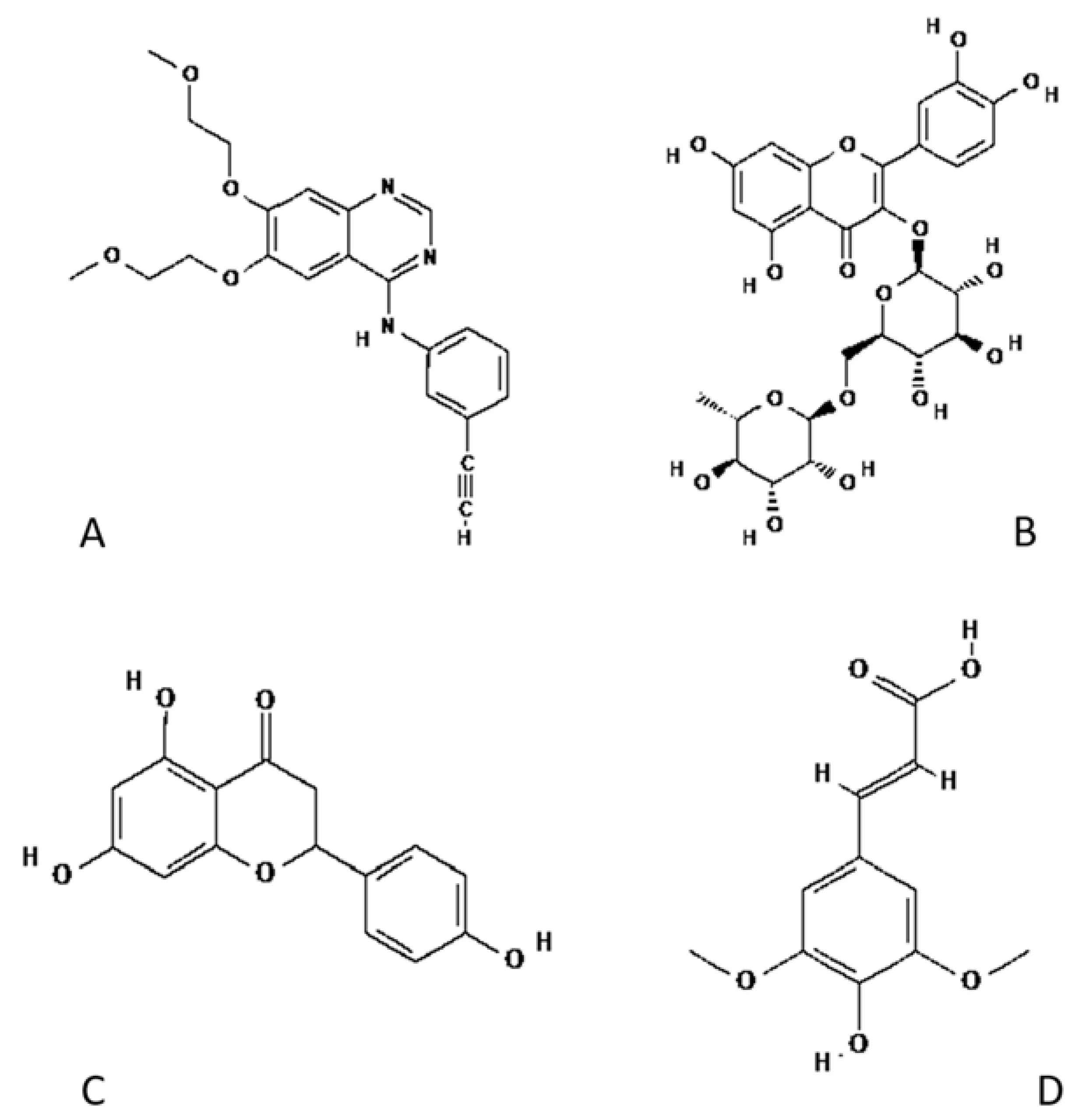
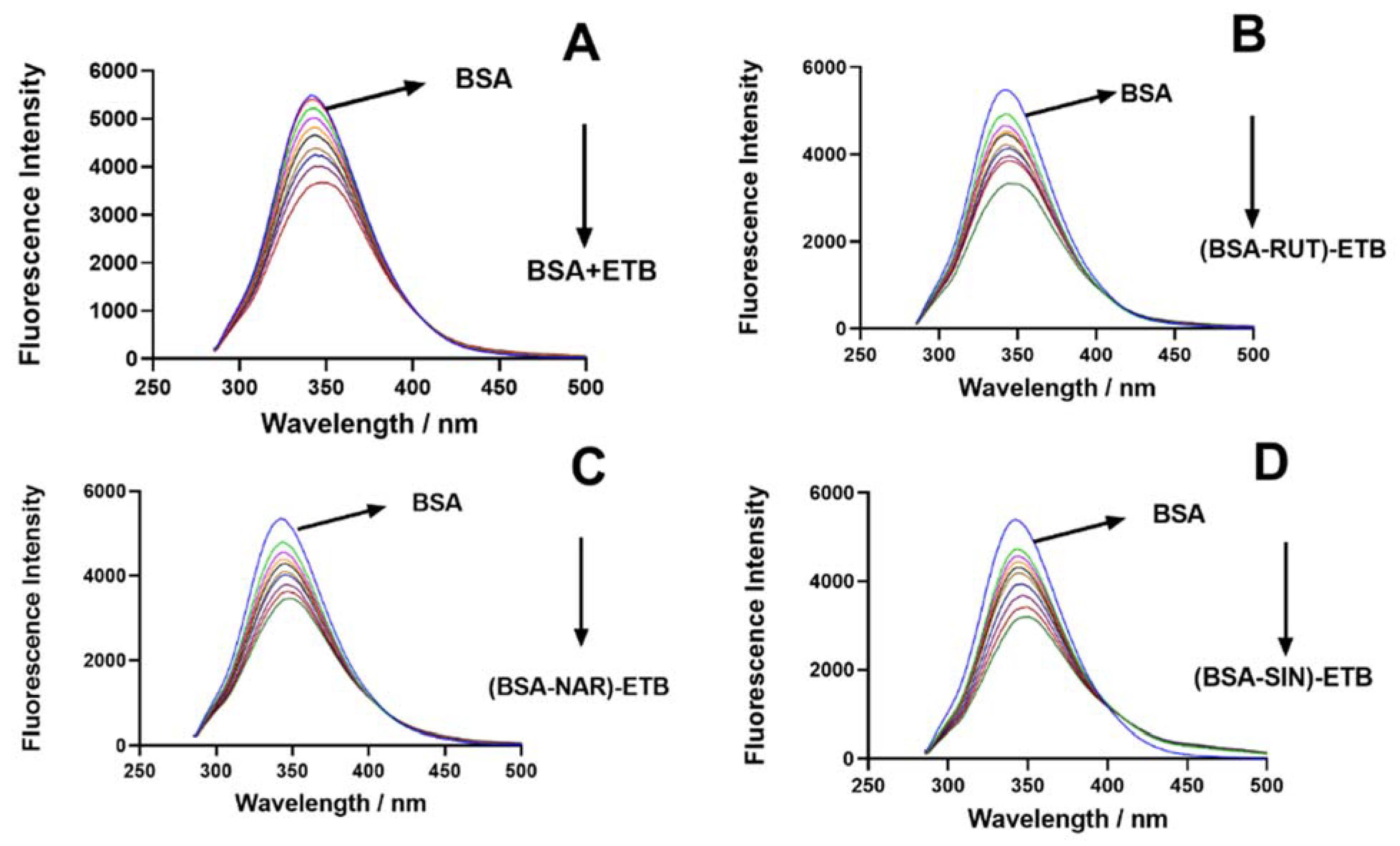
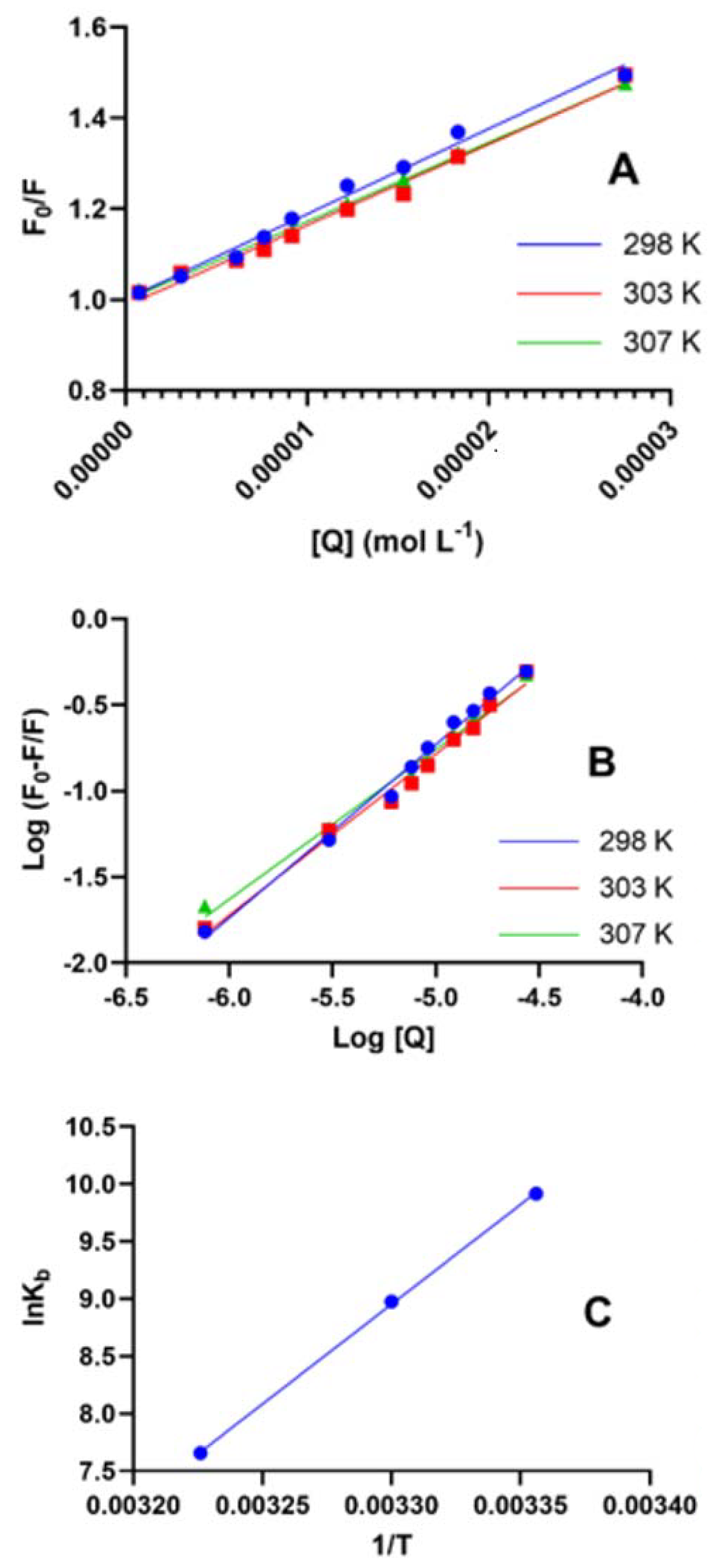



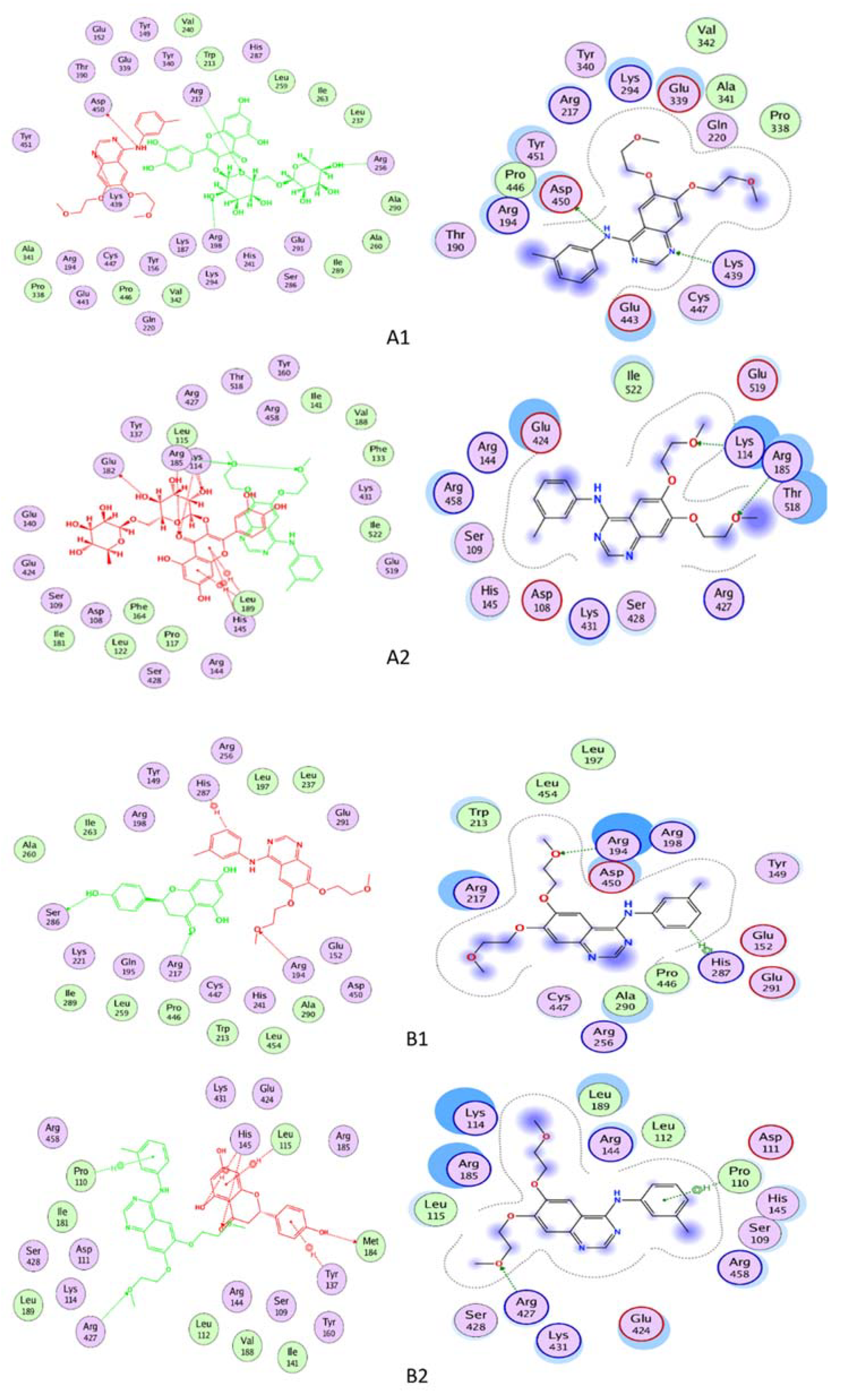
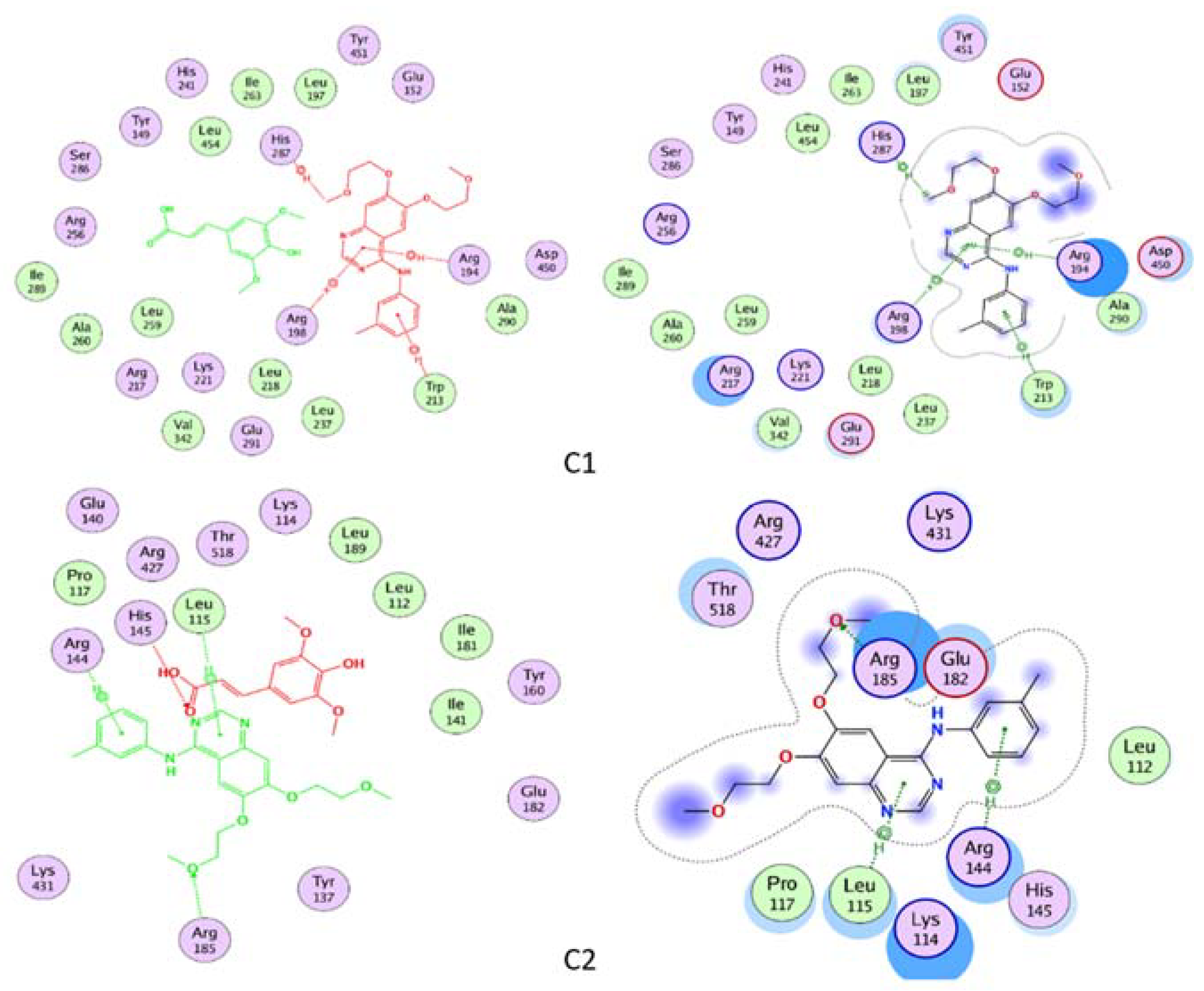
| T (K) | R | Ksv × 104 ± SD (M−1) | kq × 1012 (M−1 S−1) |
|---|---|---|---|
| 298 | 0.9890 | 1.88 | 3.14 |
| 303 | 0.9888 | 1.78 | 2.97 |
| 307 | 0.9966 | 1.74 | 2.90 |
| System | kq (M−1 S−1) | Kb |
|---|---|---|
| BSA-ETB | 3.14 × 1012 | 2.02 × 104 |
| (BSA-RUT)-ETB | 4.60 × 1012 | 1.12 × 102 |
| (BSA-NAR)-ETB | 6.21 × 1012 | 1.61 × 103 |
| (BSA-SIN)-ETB | 4.35 × 1012 | 1.02 × 103 |
| T (K) | Kb ± SD | n | ∆G° ± SD (kJ mol−1) | ∆H° ± SD (kJ mol−1) | ∆S° ± SD (J mol−1·K−1) |
|---|---|---|---|---|---|
| 298 | 2.02 × 104 | 1.0073 | −24.59 | −144.69 | −403.02 |
| 303 | 7.91 × 103 | 0.9871 | −22.57 | ||
| 307 | 2.12 × 103 | 0.9833 | −20.96 |
| Complex | Ligand | Receptor | Interaction | Distance | Score Kcal mol−1 | Subdomain | |||
|---|---|---|---|---|---|---|---|---|---|
| ETB-BSA | n33 | CD | ARG | 217 | (A) | H-acceptor | 3.39 | −9.255 | IIA |
| 6-ring | NE | ARG | 256 | (A) | pi-cation | 3.8 | |||
| ETB(BSA-NRN) | O14 | OG | SER | 286 | (A) | H-donor | 3.14 | −7.684 | |
| O1 | NE | ARG | 217 | (A) | H-acceptor | 3.04 | |||
| ETB(BSA-RTN) | N38 | OD2 | ASP | 450 | (A) | H-donor | 3.18 | −6.331 | |
| N33 | CE | LYS | 439 | (A) | H-acceptor | 3.51 | |||
| ETB(BSA-SPA) | C29 | 5-ring | HIS | 287 | (A) | H-pi | 4.15 | −7.428 | |
| 6-ring | CD | ARG | 194 | (A) | pi-H | 3.15 | |||
| 6-ring | NH1 | ARG | 198 | (A) | pi-cation | 4.31 | |||
| ETB-BSA | N33 | CA | TYR | 137 | (A) | H-acceptor | 3.49 | −7.495 | IB |
| ETB(BSA-NRN) | O28 | NE | ARG | 427 | (A) | H-acceptor | 3.21 | −6.836 | |
| 6-ring | CD | PRO | 110 | (A) | pi-H | 4.53 | |||
| ETB(BSA-RTN) | O5 | NZ | LYS | 114 | (A) | H-acceptor | 2.87 | −7.272 | |
| O28 | NH1 | ARG | 185 | (A) | H-acceptor | 3.13 | |||
| O28 | NH2 | ARG | 185 | (A) | H-acceptor | 2.97 | |||
| ETB(BSA-SPA) | O5 | NH2 | ARG | 185 | (A) | H-acceptor | 2.93 | −7.056 | |
| 6-ring | N | LEU | 115 | (A) | pi-H | 4.41 | |||
| 6-ring | CB | ARG | 144 | (A) | pi-H | 4.22 | |||
| 6-ring | CD | ARG | 144 | (A) | pi-H | 4.04 | |||
Publisher’s Note: MDPI stays neutral with regard to jurisdictional claims in published maps and institutional affiliations. |
© 2022 by the authors. Licensee MDPI, Basel, Switzerland. This article is an open access article distributed under the terms and conditions of the Creative Commons Attribution (CC BY) license (https://creativecommons.org/licenses/by/4.0/).
Share and Cite
Wani, T.A.; Bakheit, A.H.; Zargar, S.; Khayyat, A.I.A.; Al-Majed, A.A. Influence of Rutin, Sinapic Acid, and Naringenin on Binding of Tyrosine Kinase Inhibitor Erlotinib to Bovine Serum Albumin Using Analytical Techniques Along with Computational Approach. Appl. Sci. 2022, 12, 3575. https://doi.org/10.3390/app12073575
Wani TA, Bakheit AH, Zargar S, Khayyat AIA, Al-Majed AA. Influence of Rutin, Sinapic Acid, and Naringenin on Binding of Tyrosine Kinase Inhibitor Erlotinib to Bovine Serum Albumin Using Analytical Techniques Along with Computational Approach. Applied Sciences. 2022; 12(7):3575. https://doi.org/10.3390/app12073575
Chicago/Turabian StyleWani, Tanveer A., Ahmed H. Bakheit, Seema Zargar, Arwa Ishaq A. Khayyat, and Abdulrahman A. Al-Majed. 2022. "Influence of Rutin, Sinapic Acid, and Naringenin on Binding of Tyrosine Kinase Inhibitor Erlotinib to Bovine Serum Albumin Using Analytical Techniques Along with Computational Approach" Applied Sciences 12, no. 7: 3575. https://doi.org/10.3390/app12073575
APA StyleWani, T. A., Bakheit, A. H., Zargar, S., Khayyat, A. I. A., & Al-Majed, A. A. (2022). Influence of Rutin, Sinapic Acid, and Naringenin on Binding of Tyrosine Kinase Inhibitor Erlotinib to Bovine Serum Albumin Using Analytical Techniques Along with Computational Approach. Applied Sciences, 12(7), 3575. https://doi.org/10.3390/app12073575






